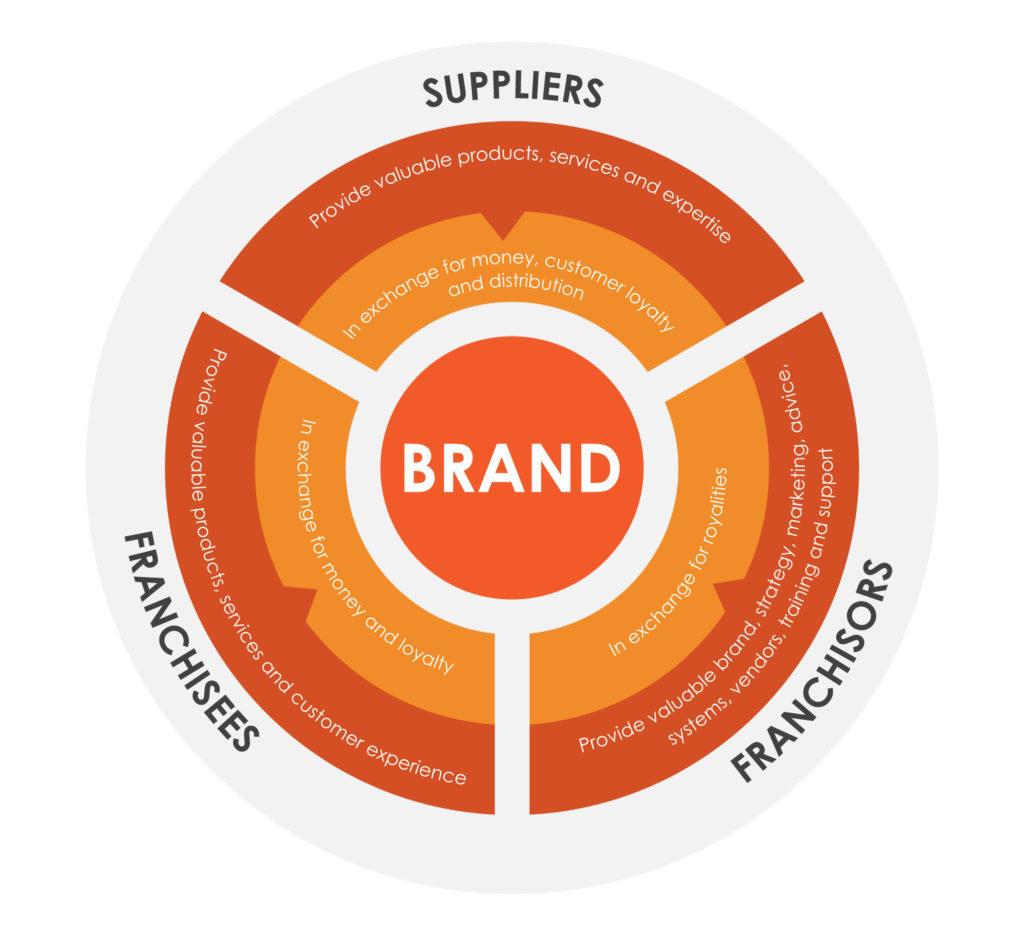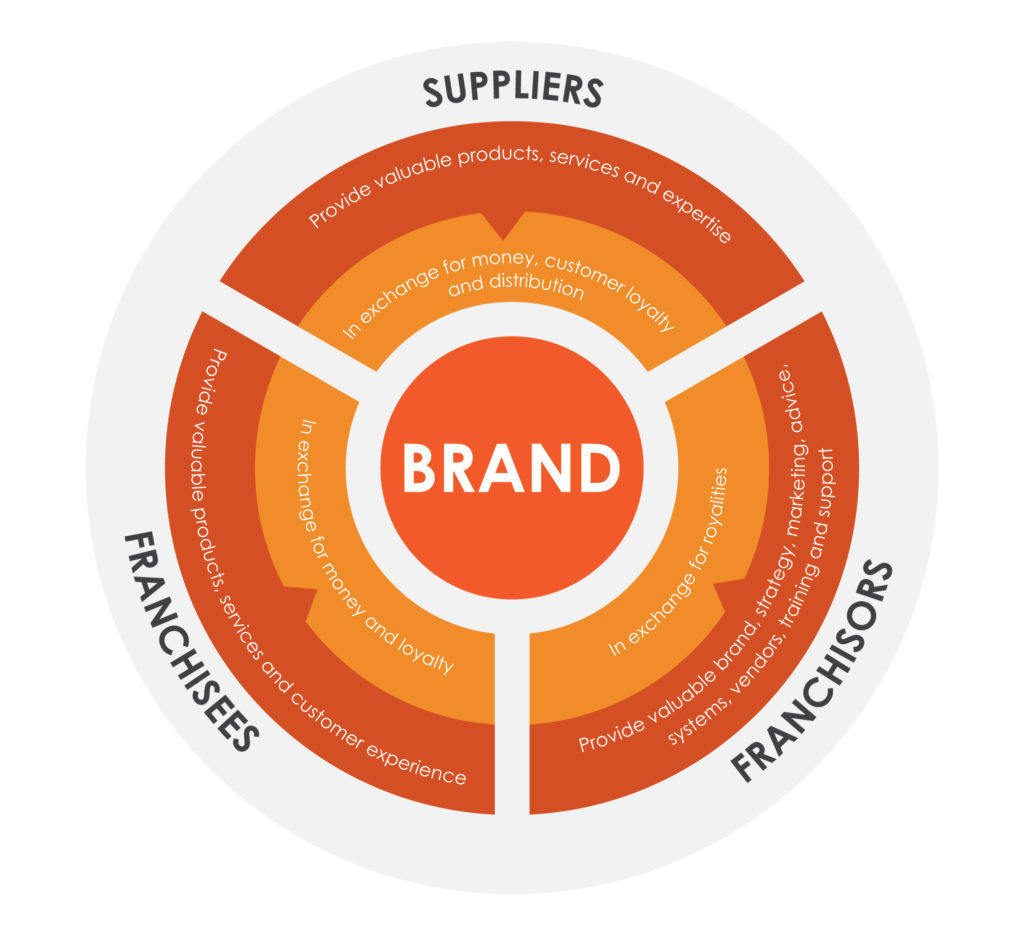
HOW CUSTOMERS DEFINE A BRAND’S VALUE
In our series on the Franchise Flywheel Effect, we’ve been examining the factors that can lead a brand to sustained momentum, and what breakdowns can bring it to a halt. The flywheel consists of everything that drives the whole brand ecosystem forward, because franchising only works when everyone involved – franchisors, franchisees, and customers – both adds value and rewards the value they receive from the other stakeholders.

FPG’s Franchise Brand Value Chain has three main components that contribute to the flywheel:
- Franchisors provide value to franchisees through their brand, marketing, tools, products, and systems.
- Franchisees provide value to customers through their products, services, and customer experience.
- Customers reward value with repeat business and referrals.
That’s why high-growth chains with well-executed franchise models outpace themselves year after year with seemingly less energy and effort than it took to produce results from the previous year. The flywheel will keep spinning under its own momentum until something disrupts it.
In our last piece, we looked at how franchise candidates perceive the value of a brand. Now, we’ll look at how customers decide on the value of a brand.
SHOW ME THE MONEY
Notice that in this model, money is generated as a byproduct of the real and perceived value the franchisees and franchisor add to their constituencies. FPG asserts iconic brands focus their time, money, and energy on unique, scalable, and replicable ways to add real and perceived value to their constituency. In the movie “The Founder,” the McDonald’s brothers made it their magnificent obsession to serve tasty hamburgers as fast as humanly possible. They were shown conducting time- and labor-saving studies decades before Lean Six Sigma.
For iconic brands and the visionary leaders behind them, money then becomes a currency of fair exchange: value for dollars. Value comes first. The more value the brand adds, the more money everyone makes. The more unique and relevant the value-add to the end user, the more sustainable the revenue streams are and the more necessary the brand becomes.
Franchisees must be keenly aware of how their customers measure their value and do not get to say what, if any, value was actually added and whether or not the money spent was worth it.
When both the franchisor and franchisees habitually add more value to their constituencies than they extract in fees, the flywheel turns, creating forward momentum. And like any object with forward momentum, it takes less energy and resources to maintain forward motion than it does to create it when the brand experiences inertia.
This leads to massive efficiencies, creating exponential growth with greater ease and fewer spent resources than in the past.
13 WAYS CUSTOMERS DEFINE VALUE
FPG has identified 13 distinct ways customers experience value. Iconic brands develop a mastery-level understanding of which of these their customers value most and use that to establish a dominant brand identity. Iconic brands don’t try to be all things to all people. They pick a customer segment to whom they are uniquely positioned to deliver the most added value.
1. Innovation
Customers acknowledge these companies as simply developing or distributing the most advanced products and services.
Apple is a good example of an innovation leader in electronics. Chem-Dry carpet cleaners have a patented technology to use carbonated water to lift stains from carpets in much the same way club soda lifts wine stains from a blouse.
Most companies relying on innovation see their products and services rapidly become obsolete and therefore rely on big R&D budgets and constant reinvestment. Most entrepreneurs looking to start franchises resist getting into businesses requiring constant reinvestment, preferring products and services with long life cycles. Unless the franchise system holds a patent or has exclusive distribution rights with companies that do, brands who rely on innovation as their key point of difference don’t seem to thrive in franchising. Franchising moves slower than technology advances, creating disruptions. For example, most franchisors don’t penetrate 100 new markets within a 10-year span. 10 years in a technology business is an eternity. By the time an innovative company can achieve any significant level of market penetration through franchising, chances are the technology or innovation will be obsolete by that time. That’s why there are few innovation leaders in franchising.
2. Necessary to the Customer
These are evergreen products and services customers simply cannot do without. FPG client Luxottica built a multi-billion dollar business by manufacturing and distributing eyeglasses and contact lenses through such retail brands as LensCrafters and franchisor Pearle Vision. Over 60% of kids, adults, and senior populations need glasses or contacts to see properly.
3. Price Leadership or “Low-Cost Provider”
These are brands that sell products cheaper than everyone else. Examples of price leaders are Walmart, McDonald’s, Taco Bell, Domino’s, and Subway. Price leadership can be a real competitive advantage or a slippery slope. Well-managed brands demonstrate high degrees of operational excellence along with a competitive advantage on supply chain. However, this strategy can also be a disadvantage as costs are always going to increase. Sometimes brands inadvertently educate their market to expect a specific price point, such as Subway’s promotion of $5 subs. When rising labor and protein costs made it unprofitable for Subway franchisees to continue with their $5 sub offering, many customers pushed back hard, rejected the higher price point, and reduced their frequency of visits, leading to sales and profitability declines for many franchisees.
4. Service Leader or “Unique Customer Experience”
These concepts bake a unique customer experience or higher service expectation into their product offering and often charge a slight premium for the value-added experience. Youth sports franchisor and FPG client i9 Sports has designed their youth sports leagues to create a positive experience for both the children and their parents. These brands invest big dollars in training and developing their staff. If the customer doesn’t value their overall customer experience, they won’t pay the premium, sales will decline, margins will get squeezed, and the brand will struggle. If customers value the experience and brands demonstrate a strong ability to replicate this experience across their network, other brands will have difficulty copying their value proposition. If poorly executed, this strategy can also backfire.
For example, Cold Stone Creamery at one time wowed customers with their system for mass customization of their ice cream. However, customization and personalization meant slower service times. As the brand grew popular and lines got longer, the increased wait times created a negative customer experience which resulted in declining sales. As Yogi Berra once said of a New York-area restaurant, “Nobody goes there anymore. It’s too crowded.” Eventually, the customer wait times fell into the range of acceptability for the customer, but unfortunately below the threshold of earnings many franchisees desired, creating many struggling franchisees.
5. High Perceived Risk of Change
These brands have an opportunity to lock up their customer base as long as they meet their customers’ minimum satisfaction threshold. Examples of these businesses include hair care brands known for hair coloring, such as resurgent Fantastic Sams. Maid service brands such as Molly Maids, Merry Maids, and The Maids enter people’s homes, so these brands must earn the customer’s trust. The customer has no way of knowing whether or not they can trust the next crew, so as long as the brand provides the minimum level of service expectation, they will create a repeat customer with a high lifetime value. This is the same for janitorial brands who work commercial accounts. Dirty bathrooms disrupt business and kill employee morale. Even if a service comes in and undercuts the existing company, the price spread may not be worth the perceived risk.
6. Customer Intimacy
These brands build deep and committed personal relationships with their clientele. Examples include senior care businesses such as Visiting Angels, Home Instead, Comfort Keepers, BrightStar Care, and ComForCare. Others form a community or tribe, like Crossfit.
7. Speed and Convenience
These brands focus on getting customers in and out fast, minimizing life disruptions and playing off the high value their time-starved customers place on time. Examples include Great Clips. These brands may charge customers a premium on price consistent with how their customers value their own time. These brands are often mobile, such as 1-800-DryClean, which picks up and delivers dry cleaning services for a premium. Little Caesars’Hot-N-Ready pizza strategy capitalizes on time-crunched soccer moms who are behind schedule and have nothing ready to feed their hungry, screaming brood. If the business is brick-and-mortar, companies need to be very skilled in real estate selection, as time-crunched customers look to stay in a small shopping orbit and “do it all” in one trip.
8. Lifestyle
Harley-Davidson doesn’t really sell motorcycles. They sell “freedom on the open road.” Also like Harley-Davidson, lifestyle brands often have high ego appeal. Lifestyle brands can also promote shared values with their customers, such as FPG client faith-based Christian Brothers Automotive.
9. Aspirational
These are business that sell premium services and luxury brands, such as Lexus. FPG client Snap-on Tools is the professional mechanic’s hand tool of choice and serves as a badge of honor for mechanics around the service bay.
10. Disruptive
These brands reinvent products and services, altering what customers now value and how they shop. Planet Fitness disrupted the highly commoditized and undifferentiated gym model through a high-value and low-cost offering. Jiffy Lube disrupted car maintenance service by inventing a method for oil change and basic car care in 30 minutes or less. Disruptors often give their franchisees a 2-5 year head start on the competition before copycat concepts roll out. They need to grab the “first mover” position or they will lose to a copycat concept that accelerates past them.
11. Socially responsible
These brands have the reputation for being solid corporate citizens who give back to the planet or local community. TOMS shoes is a classic example. While many franchisees give back to their local community, these brands build charity into their brand identify and tie it to their product or service offering. Under its original leadership, Ben & Jerry’s ice cream was in the business of furthering their progressive social agenda funded with the proceeds from sales of premium ice cream.
12. High-Value/Affordable Luxury
These are premium brands with products or services still within reach of middle-income America. For instance, Massage Envy made spa services more affordable and convenient for middle-income families.
13. Expertise/Thought Leadership
These brands are highly focused and have deep domain knowledge within their industry. FPG client Re-Bath specializes in lower cost and less invasive bathroom remodeling by using acrylic molds and liners that resemble granite, marble, and other surfaces. FPG competes as a thought leader by offering clients proven intellectual property, strategic relationships, and a proven business platform for growing national franchise brands.
This may not be an exhaustive list of key points of difference. The important thing a franchisor must remember is that they need to declare what value they are uniquely positioned to add, identify what customer segments will get their value and then operate on a genius level to stake out their brand position to generate and maintain key customer relationships.
Keep in mind some brands need to be competent in more than one of these characteristics to succeed, but customers of iconic brands most often define them by one.
GO SLOW TO GO FAST
Too often, franchisors launch before their consumer-facing model demonstrates it can both differentiate itself to their target customers and create sustainable value.
For instance, years ago, the market was flooded by meal-preparation concepts like Super Suppers, Dream Dinners, and My Girlfriend’s Kitchen. Women would gather together and make a week’s worth of family dinners using the brand’s commercial kitchens and ingredients. Busy mothers only needed to warm and serve their food later at home.
There was a high initial adoption rate as many women flocked to these concepts to try them out. However, they didn’t see the value of returning. Brands shuttered hundreds of locations around the country and the category is materially dead except for a few hangers-on. Why? It looked like a good idea, but once their novelty wore off, their target customer didn’t value what they offered.
A highly successful Wall Street Money manager once sent me a business summary of a new restaurant concept his Ivy League friends were raising capital for. It was a breakfast cereal specialty restaurant chain. As he walked me through the deck, he emphasized their leadership credentials and impeccable primary market research, which identified an untapped market segment of adult males who regularly eat cereal for lunch and dinner (myself included here). He asked me what I thought. I told him, “Don’t put money into it.”
He pushed back saying, “These guys all have Ivy League pedigrees. They really did their homework. All their research, market indicators, and cultural trends say it will work.”
I said, “I think they may have overlooked one important factor.”
“What’s that?”
“It kind of sounds stupid.”
After a brief period of customer trial, their restaurants quickly went bust.
MORE ON THE FRANCHISE FLYWHEEL EFFECT
This article is the final piece in a five-part series on the Franchise Flywheel Effect. Read the entire series here:
- Open Letter to Smart Franchisors: Capitalize on the Current Market Disruption
- The Best Predictors of a Franchisor’s Success
- The Franchise Flywheel Effect
- How Franchise Candidates Define Value
JOIN THE NEW FRANCHISING THOUGHT LEADERS LINKEDIN GROUP
Join FPG’s moderated LinkedIn Group dedicated to forward-thinking franchisor professionals, franchisees, suppliers, private equity, lenders, and all students of the franchising industry.
Franchising Thought Leaders. No advertising. No personal agendas. Just “must-read” content, thoughtful discussion, case studies, and debate about franchising best practices and the future of franchising.
